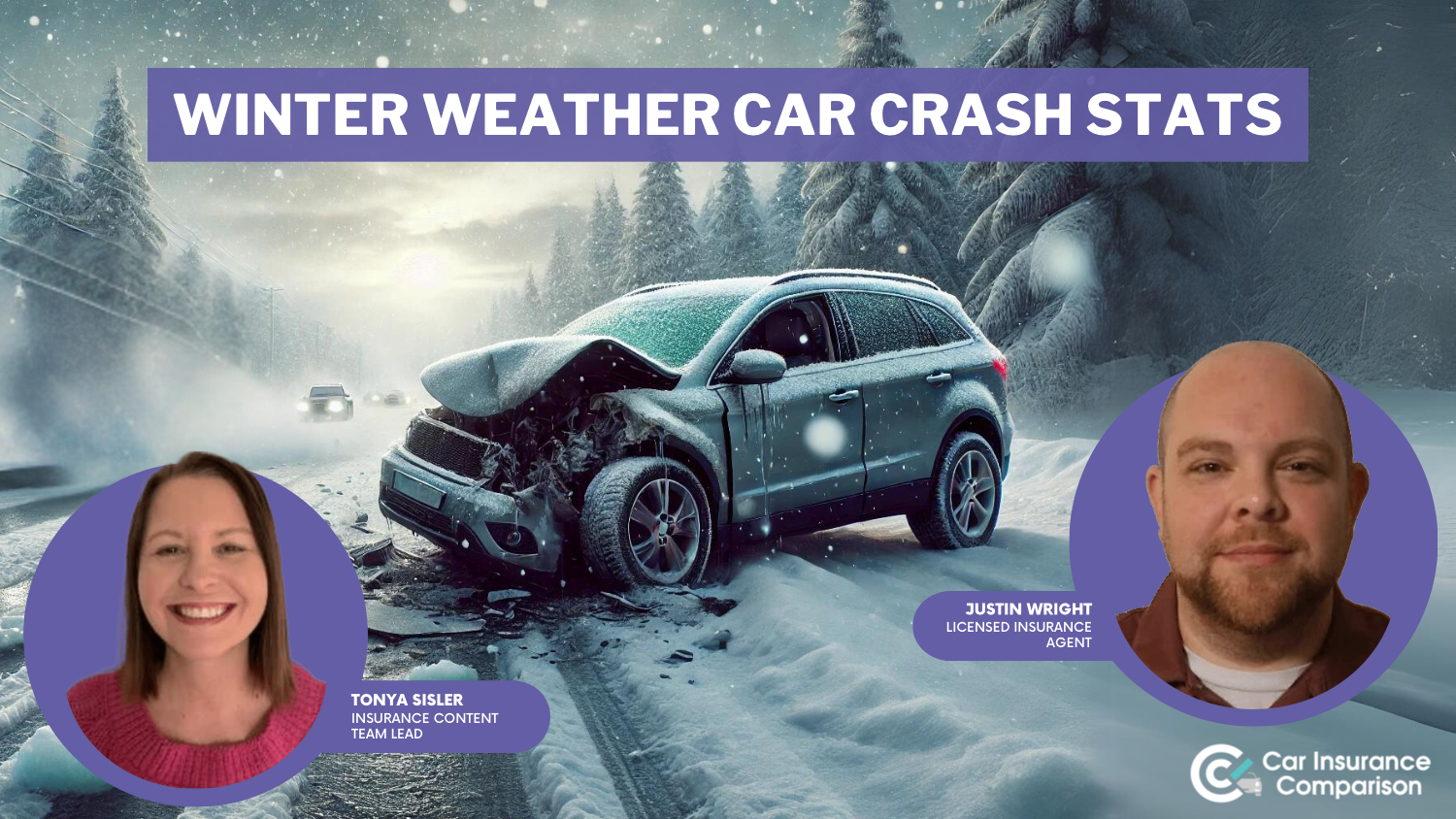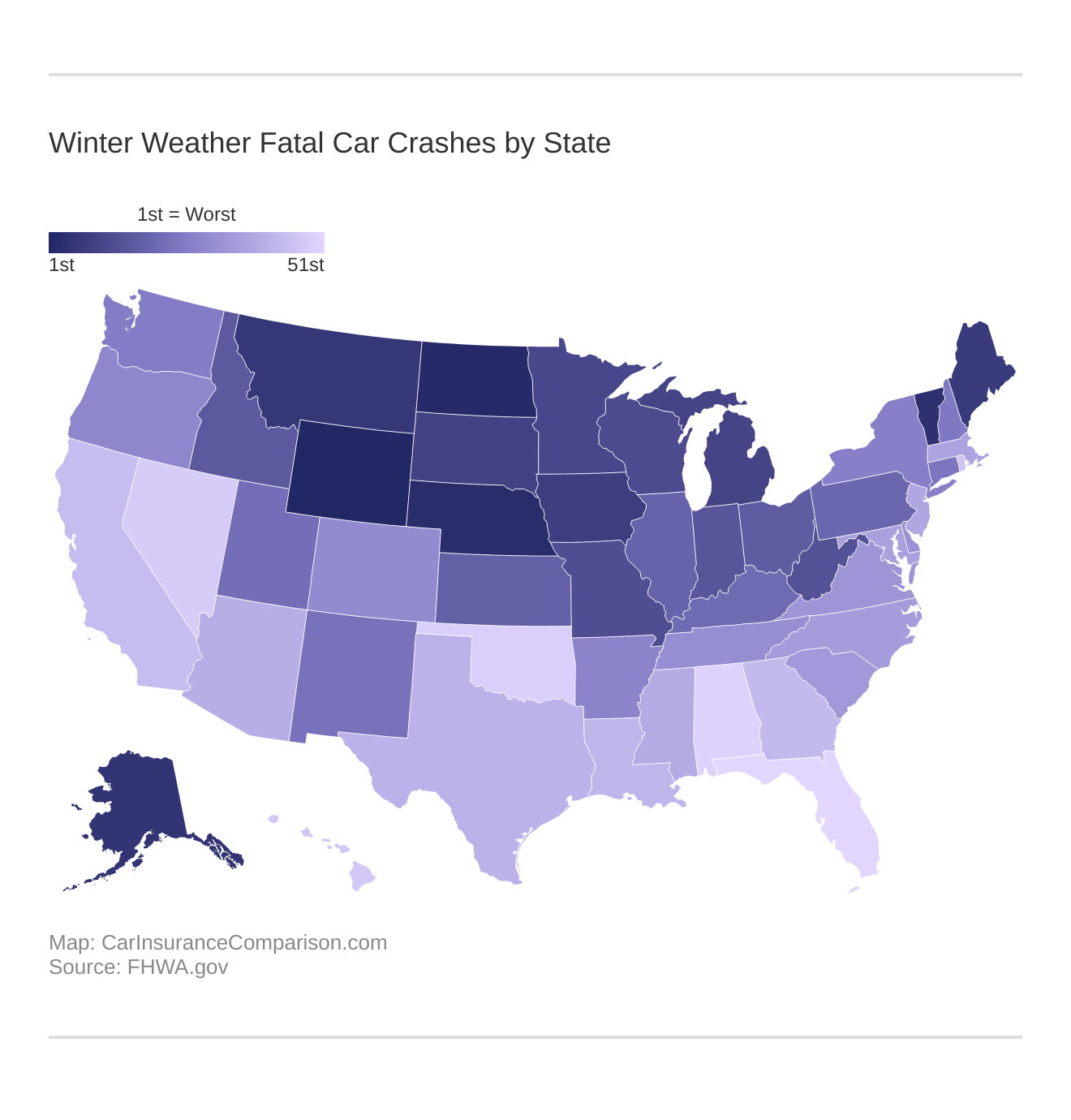25 Facts About Winter Weather Car Crashes [2026 Report]
While researching facts about winter car crashes, we discovered that 562,000 car accidents occur due to snow, sleet, slushy, or icy roads. Car accidents in the snow can be terrifying.
Read more Secured with SHA-256 Encryption





Table of Contents
Table of Contents


Insurance Content Team Lead
Tonya Sisler has been a technical insurance writer for over five years. She uses her extensive insurance and finance knowledge to write informative articles that answer readers' top questions. Her mission is to provide readers with timely, accurate information that allows them to determine their insurance needs and choose the best coverage. Tonya currently leads a team of 10 insurance copywrite...
Tonya Sisler


Licensed Insurance Agent
Justin Wright has been a licensed insurance broker for over 9 years. After graduating from Southeastern Seminary with a Masters in Philosophy, Justin started his career as a professor, teaching Philosophy and Ethics. Later, Justin obtained both his Property & Casualty license and his Life and Health license and began working for State Farm and Allstate. In 2020, Justin began working as an i...
Justin Wright
Updated October 2024
Winter weather is dangerous. Snow, sleet, slush, and ice can cause hazardous road conditions, leading to traffic delays, car crash injuries, and traffic deaths.
In this eye-opening article covering facts about winter weather car crashes, you will learn:
- How many deaths icy roads cause per year
- The worst state for winter-related fatal crashes
- The percentage of weather-related crashes related to icy roads
- The money governments spend on winter weather operations
We’ll cover weather-related car accident statistics, icy road accident statistics, and accidents caused by snow.
There will also be a section with 10 tips for winter driving and an answer to the thorny question of who is liable if your vehicle slides on ice and hits another vehicle, person, or piece of property.
The truth is, winter weather affects the majority of the country, and each state has particular car insurance laws relating to winter weather, which makes learning from specific state auto insurance guides very important.
If you’ve been in a winter weather car accident, it’s likely your car insurance rates went up. Fortunately, there are still ways to save. One of those ways is to compare live quotes from different auto insurance companies.
Enter your ZIP code into our free online quote comparison tool to do just that and start saving on car insurance today. Now, prepare to be stunned by our winter weather car crash facts. Let’s get started.
- There are over 2 million weather-related accidents each year
- Winter weather causes three traffic deaths per 1,000 accidents
- Icy roads are the most dangerous winter weather condition
- Most of America experiences at least 5 inches of snowfall per year
Free Insurance Comparison
Compare Quotes From Top Companies and Save
Secured with SHA-256 Encryption
25 Shocking Facts About Winter Weather Car Crashes
With most of America living in a place that receives at least 5 inches of snow, it can be helpful to know exactly how icy roads affect our driving, traffic deaths, and government budgets.
Winter driving is more dangerous in some states than others, even after you account for the amount of snow fallen.
Scroll for the 25 facts about winter weather crashes. We’ll start with the worst state in the country, which has the most fatal crashes during snow and sleet conditions per capita, and move down from there.
#1 – Wyoming is the worst state for fatal crashes caused by snow and sleet
Wyoming, which receives between 45 and 70 inches of snow depending on the area within the state, ranks worst for accidents related to snow and sleet with 34 fatal crashes per 1 million registered drivers. In addition to the amount of snow, the western part of Wyoming features mountain ranges and difficult driving conditions.
These conditions impact Wyoming car insurance as well.
#2 – During our study period, only six states had zero fatal crashes caused by snow or sleet
Six states ranked the best in fatal crashes per capita during snowy or sleet conditions: Florida, Alabama, Oklahoma, Nevada, Hawaii, and Rhode Island. The first five receive very little snowfall, but Rhode Island receives between 20 and 55 inches per year depending on the part of the state. This may be a signal of good driving from residents of Rhode Island.
#3 – 70% of U.S. roads get at least 5 inches of snow annually
This is most of the U.S. Because of this amount of snowfall, drivers are at risk during the winter months, and governments must spend a great deal of money making sure the roads are safe.
#4 – Icy pavement causes 13% of all weather-related car crashes
In terms of the number of weather-related crashes by condition, icy pavement ranks fourth behind wet pavement, rain, and snow/sleet. It is also the fourth-deadliest weather condition, ranking behind wet pavement, rain, and fog.
#5 – The location in America that gets the most annual snowfall is Washington’s Mt. Rainier
With the fifth-highest peak in the United States, Mt. Rainier receives the most snow in America with 656 inches of snowfall annually. It also happens to be the most dangerous volcano in the Cascade Range.
One popular activity in many winter weather states is snowmobiling. But you might be surprised that some states have insurance laws that make insurance required for snowmobiles.
#6 – Icy pavement reduces vehicle traveling speeds by 6-17%
General safety precautions dictate that drivers reduce speed during inclement weather conditions. While that doesn’t always happen, icy pavement tends to reduce traffic speeds between 6% and 17%.
#7 – Winter road maintenance accounts for nearly 25% of most states’ DOT budgets
The winter season is a busy time for state governments, which must roll out snow plows and salt trucks to keep roads safe for drivers. This costs quite a bit, accounting for 20% of state DOT budgets.
#8 – The U.S. government spends $2.3 billion annually on winter road maintenance
That amount — that state and local governments spend on winter weather control operations — is $2.3 billion and oftentimes more. That is approximately 25,600 Tesla Model Xs, the most expensive car the company sells.
#9 – Annually, there are more than four fatal crashes for every 1 million drivers due to snow or sleet
The entire U.S., including warm-weather states like Florida and Hawaii, average 4.1 fatal crashes during snow or sleet conditions per 1 million drivers. The worst states were Wyoming, North Dakota, and Nebraska.
#10 – 688 people are killed in car accidents involving snow or sleet each year
Although snow and sleet are not as dangerous as icy roads, they can still be dangerous for some drivers. There are almost 900 traffic deaths every year due to snow and sleet conditions, which can lessen traction between a vehicle’s tires and the road as well as reduce visibility.
Knowing the difference between collision and comprehensive insurance claims (and the policies themselves) is critical if you live in an area with bad winter weather. Both types of insurance protect you financially, but for different reasons.
#11 – Annually, nearly 55,000 people are injured in traffic accidents due to snow or sleet
This makes for an awful lot of auto insurance claims and highlights the importance of having personal injury protection insurance or MedPay insurance.
#12 – Snow and sleet are the 3rd-most common cause of deadly weather-related car crashes
Snow and sleet cause 18% of weather-related auto accidents, ranking just after wet pavement and rain as the largest cause of weather-related accidents. Although snow and sleet might not be as dangerous as icy pavement (persons killed per crash), it causes more crashes, resulting in more traffic deaths.
All sorts of inclement weather conditions can cause major issues with rain, causing over half a million auto accidents per year, one of many facts about driving in bad weather.
#13 – Snow, ice, and fog account for 544 million hours of traffic delays per year
We’ve all seen the photos of vehicles lined up for miles down the road, the traffic ground to a halt due to weather conditions. In fact, this is so dangerous that many state governments up north recommend having a safety kit if this were to happen, in order to not freeze to death.
#14 – Hawaii is the state in America that gets the least amount of frozen precipitation
They say it’s paradise and certainly, it has that statistic working in its favor. Known for its beaches, mountains, volcanos, golfing, hula hooping, and ukeleles, Hawaii is one of the top tourist vacation spots in the world and can add the least snowy state to its list of titles, receiving zero snow per year.
#15 – In the continental U.S., Florida gets the least amount of snow
But if you’re looking to get away from the snow but want to stay stateside, Florida is a great option. It receives just 0.2 inches of snow per year and that snow is generally dropped on the panhandle. If you move to central or south Florida, you should be in the free and clear.
#16 – Of all inclement weather, heavy snow reduces traffic speed the most
Heavy snow is one of the most dangerous winter weather conditions, as it can result in limited to no visibility. For that reason, it is the weather element that reduces traffic the most, sometimes up to 40%.
#17 – Half of the worst states for snow or sleet fatal car crashes are in the Midwest
Those are North Dakota, Nebraska, Iowa, South Dakota, and Michigan. While the terrain in Midwestern states is generally flat, these states can see a ton of snow as cold fronts from the Artic often dip into the Midwestern states, dropping a great deal of snow.
#18 – Three of the 10 worst states for snow or sleet fatal car crashes are in the West
Those are Wyoming, Alaska, and Montana. Not only do these states see a great deal of snow per year, but they also have difficult driving terrain, which can increase the chance of fatal car crashes.
#19 – Two of the worst states for snow or sleet fatal car crashes are in the Northeast
Vermont and Maine are those two states. Maine experiences between 50 and 110 inches of snow per year, depending on the area, and Vermont receives up to 124 inches (that’s excluding Mt. Mansfield). Both of these states have difficult driving terrain due to the Appalachian Mountains, which increase driving danger even without winter conditions.
#20 – Traffic speeds decrease up to 40% on snowy or slushy roads
Within cities, snowy or slushy roads can cause a decline of 30 to 40% of traffic speed. This is partly due to visibility, as snowy conditions can reduce how far and wide a driver can see. It is also partly due to the dangers of those roads and the reduced traction between the tires and roads, which could lead to spinouts or drifting.
#21 – Snow, sleet, and icy pavement account for 33% of all weather traffic deaths
Winter weather conditions account for a third of all traffic deaths due to weather conditions. In general, they are not as dangerous as wet pavement or rain but they still pose harm, especially to an inexperienced driver.
Although we’ll cover specific tips for driving in winter weather, learning how to drive safely in bad weather, in general, is very helpful as many of the same tips can be applied to different weather conditions.
#22 – 70% of U.S. residents live in areas that get 5 or more inches of snow
As we’ve seen, winter weather driving can be incredibly difficult and dangerous. This statistic underpins the need for winter driving schools and educational courses, which might help reduce winter weather traffic deaths.
#23 – Most of the safest states for snow or sleet fatal car crashes are located in the South
Of the 10 safest states for snow or sleet fatal car crashes, five are in the South. They are Florida, Alabama, Oklahoma, Louisiana, and Georgia. Together, the five states had just two snow or sleet fatal crashes during our study period.
#24 – Icy roads are the 4th-most likely cause of a fatal car crash out of all weather conditions
For our 10-year analysis, icy roads cause on average 156,000 auto accidents, 42,000 persons injured, and 20 deaths annually. This makes it the fourth most dangerous weather condition and the worst out of all winter weather conditions.
#25 – Snowy, slushy, and icy pavement cause over 1,300 traffic deaths each year
Combined, winter weather’s effect on pavement leads to thousands of deaths and hundreds of thousands of injuries each year. Loss of control of a vehicle can be one of the scariest experiences for a driver and one of the deadliest in general.
Read more: Top 10 Deadliest Vehicles in History
10 Tips for Driving in Winter Weather
Now that we’ve covered the dangers of driving on icy pavement or during inclement winter weather, let’s get to some tips to keep you safe next time you’re on the road during one of these periods.
#1 – Keep Your Tires Properly Inflated
Winter weather — the cold — automatically creates a drop in the air pressure of your tires. Make sure to check them frequently and keep them inflated according to the instructions in your driver’s manual. Low-pressure tires have less traction compared to normal-pressure tires, which would make winter weather driving even more dangerous.
#2 – Reduce Your Driving Speed
As we’ve seen, winter weather reduces traffic speed, and for good reason. The slower you drive, the more time you have to respond to situations, especially when there is decreased visibility. Also, when you drive fast in winter weather, you run the risk of losing control over your vehicle much more rapidly than if you were driving slowly.
#3 – Keep Proper Following Distance
Another way to keep safe while driving in winter weather is to increase the distance between you and the cars in front of you. Don’t get sucked into groups of vehicles driving together. Keeping a proper distance gives you more time to react, which is crucial on icy or snowy roads where you might have trouble stopping.
#4 – Get Winter Weather Equipment
If you live in an area that consistently receives large amounts of snowfall, a good investment might be in winter-weather equipment such as specific snow tires, tire chains, or even a four-wheel-drive vehicle. These reduce the chances of an accident or in the case of the last one, can keep you from getting stuck.
#5 – Build a Winter Safety Kit
No matter how many precautions we take, there is always the chance of getting stuck — either in traffic or in a ditch. In those situations, you’ll need a winter safety kit that can ward off the cold and keep you communicated with people who can help you. Some things to include are first aid materials, blankets, hand-cranked battery devices, food, water, and a list of numbers you can call in the event of an emergency.
#6 – Take a Winter Driving Course
Winter driving creates some unique driving situations that require skills you might not otherwise use. For instance, if the back of your car starts to drift right, turn left (slowly) instead of turning to the right and creating a spin. A good winter driving school can teach you the fundamentals of winter driving so you’ll be more prepared when the next storm comes.
#7 – Try to Avoid Driving in Bad Weather
One of the most important safety measures you can take during winter weather is to prepare ahead of time and not go out while the roads are precarious. While this isn’t always possible due to work, minimizing the time spent on winter roads minimizes the possibility of an accident.
#8 – Don’t Neglect Your Windshield Wipers
Probably, one of the scariest parts of winter weather driving is lack of visibility. When you can’t see very far in front of you, you are at the mercy of the elements and may start to panic. This is especially true if ice chips start to form on your windshield. In this situation, your windshield wipers combined with a defroster blaring heat become your best friend. Make sure they’re up to date, in good quality, and can handle removing ice chips or hard objects from your windshield.
#9 – Driving Experience Helps
If you are brand new to winter weather driving, you may be intimidated by driving on snow, ice, or during a storm. But as you gain more experience, you’ll become more knowledgeable, confident, and sure of what your car can do and can’t.
#10 – Avoid Overconfidence and Negligence
There is a fine line between having confidence driving in winter weather and being overconfident. Speeding recklessly in the snow, turning too quickly on ice, and not keeping your vehicle updated or tires inflated could lead to disaster.
All States Ranked by Snow or Sleet Driving Risk
We’ve noted a few times the worst states and best states for snow or sleet driving. You might be wondering how your state ranks, however. The table below shows all 50 states ranked according to fatal crashes per capita during snow and sleet conditions. First is worst on this list.
Worst (& Best) States for Winter Weather Fatal Car Crashes
| Rank | State | Snow/Sleet Fatal Crashes | Fatal Crashes Per Capita |
|---|---|---|---|
| 1 | Wyoming | 14 | 34.1 |
| 2 | North Dakota | 11 | 19.6 |
| 3 | Nebraska | 18 | 12.7 |
| 4 | Vermont | 7 | 12.5 |
| 5 (tie) | Alaska | 6 | 11.3 |
| 5 (tie) | Montana | 9 | 11.3 |
| 7 | Maine | 10 | 9.6 |
| 8 | Iowa | 18 | 8.0 |
| 9 | South Dakota | 5 | 7.9 |
| 10 | Michigan | 55 | 7.7 |
| 11 | Minnesota | 25 | 7.4 |
| 12 | Wisconsin | 30 | 7.0 |
| 13 | Missouri | 28 | 6.6 |
| 14 | West Virginia | 6 | 5.3 |
| 15 | Indiana | 23 | 5.0 |
| 16 | Idaho | 6 | 4.8 |
| 17 | Ohio | 36 | 4.5 |
| 18 | Kansas | 9 | 4.2 |
| 19 | Illinois | 32 | 3.7 |
| 20 (tie) | Pennsylvania | 30 | 3.3 |
| 20 (tie) | Kentucky | 10 | 3.3 |
| 22 | Utah | 6 | 3.0 |
| 23 | New Mexico | 4 | 2.8 |
| 24 | Connecticut | 7 | 2.7 |
| 25 | New Hampshire | 3 | 2.6 |
| 26 | Washington | 13 | 2.2 |
| 27 | New York | 25 | 2.1 |
| 28 | Arkansas | 4 | 1.9 |
| 29 | Oregon | 5 | 1.7 |
| 30 | Colorado | 6 | 1.4 |
| 31 (tie) | Tennessee | 7 | 1.3 |
| 31 (tie) | Delaware | 1 | 1.3 |
| 33 | Virginia | 7 | 1.2 |
| 34 | South Carolina | 4 | 1.0 |
| 35 (tie) | North Carolina | 7 | 0.9 |
| 35 (tie) | Maryland | 4 | 0.9 |
| 37 (tie) | Massachusetts | 4 | 0.8 |
| 37 (tie) | New Jersey | 5 | 0.8 |
| 39 | Mississippi | 1 | 0.5 |
| 40 | Arizona | 2 | 0.4 |
| 41 (tie) | Texas | 6 | 0.3 |
| 41 (tie) | Louisiana | 1 | 0.3 |
| 43 | Georgia | 1 | 0.1 |
| 44 | California | 1 | 0.0 |
| 45 (tie) | Rhode Island | 0 | 0.0 |
| 45 (tie) | Hawaii | 0 | 0.0 |
| 45 (tie) | Nevada | 0 | 0.0 |
| 45 (tie) | Oklahoma | 0 | 0.0 |
| 45 (tie) | Alabama | 0 | 0.0 |
| 45 (tie) | Florida | 0 | 0.0 |
As you can see, states in warmer climates fared the best, while states in colder climates, particularly those with mountainous terrain, fared the worst. Five of the worst states for snow or sleet fatal crashes are located in the West, three are in the Midwest, and two are in the Northeast.
Almost all the best states are in the South or West, with Rhode Island being a large exception. It receives dozens of inches of snow per year but didn’t record a fatal car crash due to snow or sleet during our study. Kudos to Rhode Island drivers for this.
Free Insurance Comparison
Compare Quotes From Top Companies and Save
Secured with SHA-256 Encryption
Frequently Asked Questions: The Dangers of Winter Weather Driving
Now, let’s get to your frequently asked questions. Here, we cover winter weather car crash statistics, including accidents by type of winter weather condition.
We also get into that thorny issue of who is responsible for an accident if your car slides on ice and hits another vehicle, person, or piece of property.
#1 – How many accidents are caused by winter weather?
During our 10-year study period, winter weather caused on average 562,182 car accidents annually.
#2 – What is the number one cause of winter accidents?
The number one cause of winter car accidents is snow and sleet conditions, which lead to nearly 220,000 car accidents every year.
#3 – How many people die in winter car accidents?
On average, 1,705 people die each year in winter car accidents.
#4 – How many accidents happen from ice?
Annually, icy pavement causes 156,164 car accidents.
#5 – Is sliding on ice an at-fault accident?
Unfortunately, if your car slides on ice and hits another car, person, or piece of property, you are considered at fault in the accident and responsible for the damages.
#6 – How many people die in accidents caused by snow every year?
Snow and sleet conditions kill 688 people in car accidents every year.
#7 – How dangerous is snow?
Snow is very dangerous. Aside from leading to hundreds of people dying each year in car accidents, it can cause people to freeze to death. Around 100 people also die shoveling snow each year. It is quite dangerous.
#8 – Can you die if you sleep in the cold?
Yes, hypothermia kills around 600 Americans each year, mostly the result of cold-weather recreation activities. But there are also situations where people have died from cold in their own homes if they lose power and the temperature plummets.
Methodology: Winter Weather Car Crash Study
For this study, our researchers collected data on six different types of weather conditions:
- Wet pavement
- Rain
- Snow or sleet
- Icy pavement
- Snowy or slushy pavement
- Fog
The data collected was total car accidents, total persons injured, and total persons killed. The data came from the Federal Highway Administration (FHWA) and covered over a decade from 1996 to 2017.
Our analysts used the data to come up with major statistics, including persons killed per accident by weather condition and the most dangerous states for the snow/sleet weather condition.
The sources also included Weather.com for the snowfall statistics.
Ready to save on car insurance? Plug your ZIP code into our free online quote tool to compare rates and start saving today.
[/su_spoiler]

Frequently Asked Questions
How many car accidents occur due to winter weather conditions?
Approximately 562,000 car accidents occur due to snow, sleet, slush, or icy roads.
Which state has the highest number of fatal crashes caused by snow and sleet?
Wyoming is the worst state for fatal crashes caused by snow and sleet, with 34 fatal crashes per 1 million registered drivers.
How much does winter road maintenance account for in most states’ DOT budgets?
Winter road maintenance accounts for nearly 25% of most states’ Department of Transportation (DOT) budgets.
How many traffic deaths occur annually due to car accidents involving snow or sleet?
Approximately 688 people are killed in car accidents involving snow or sleet each year.
What are some tips for driving in winter weather?
Some tips for driving in winter weather include keeping your tires properly inflated, reducing your driving speed, maintaining a proper following distance, and using caution on icy roads.
Get a FREE Quote in Minutes
Insurance rates change constantly — we help you stay ahead by making it easy to compare top options and save.








